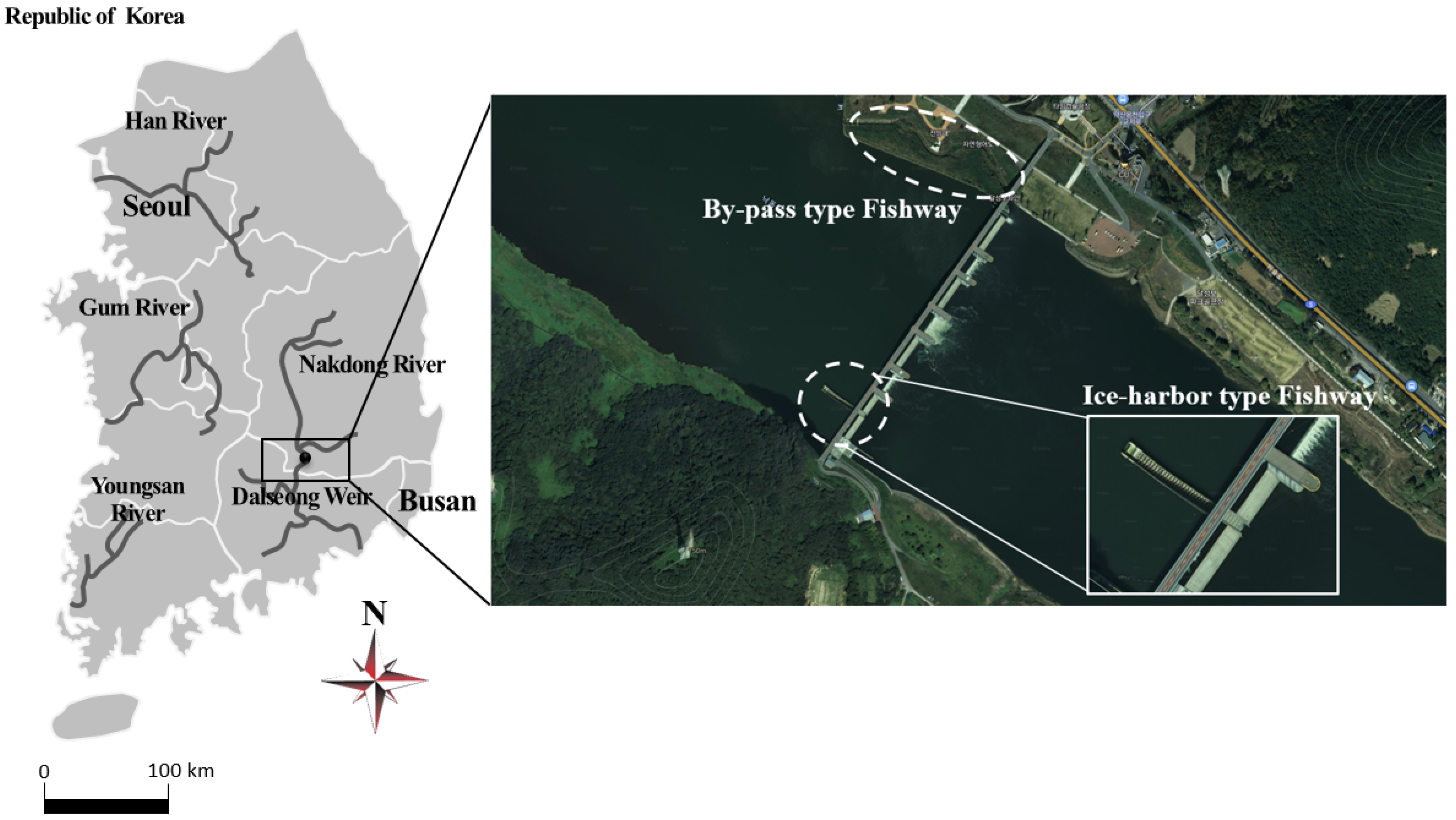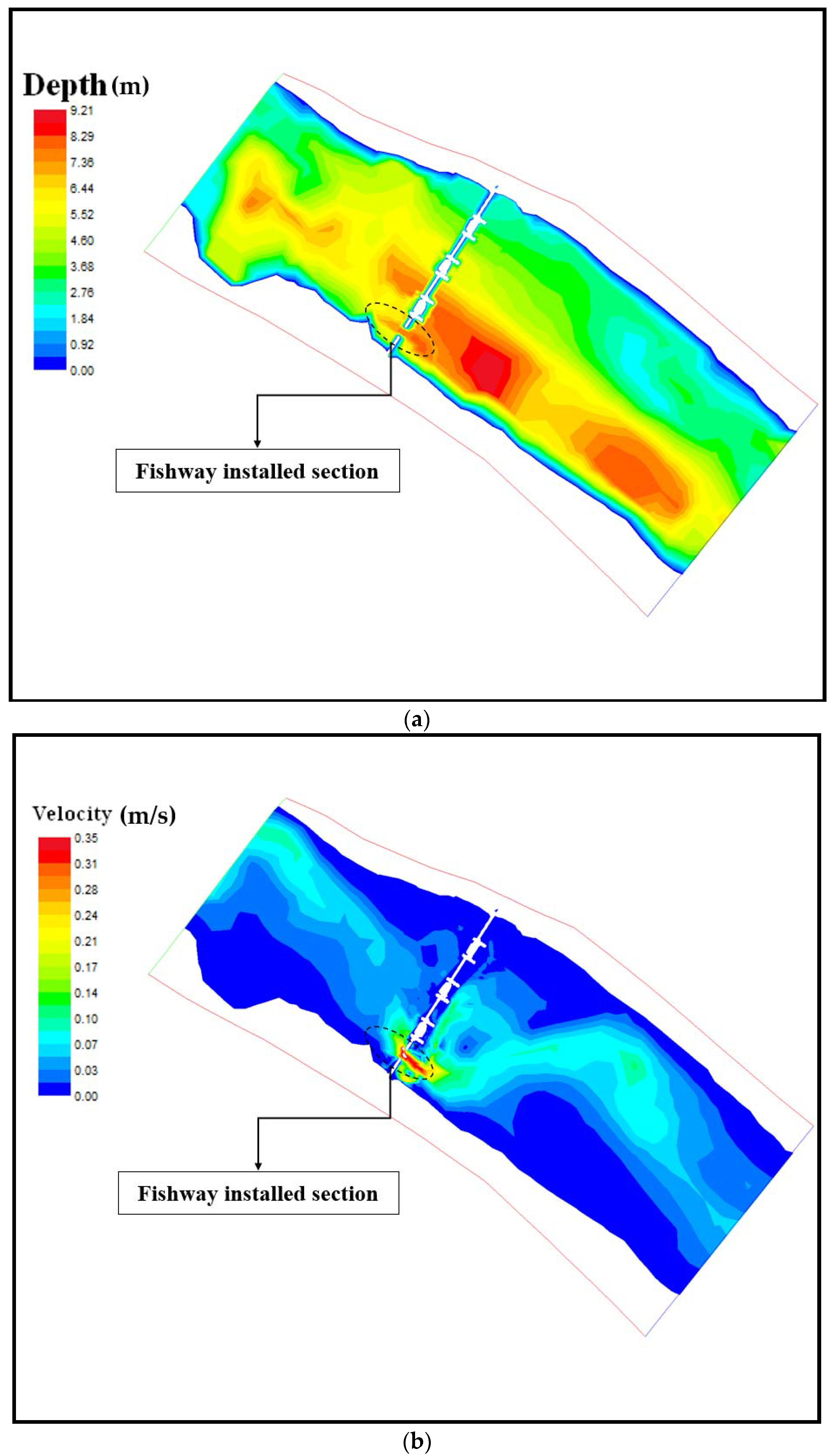Evaluating Attraction and Passage Efficiencies of Pool-Weir Type Fishways Based on Hydraulic Analysis
Abstract
:1. Introduction
2. Efficiency Evaluation Tools
2.1. Attraction Efficiency Evaluation Tool: River 2D
- ①
- Close to upstream side: If the weir is not installed perpendicular to the flow direction, the ascending fish try to move upstream along a weir. Thus, the fishway should be installed in riverside close to the upstream sided, so that fish can find the fishway entrance [12].
- ②
- Near the thalweg line: During the low water and dry seasons, the flow occurs mainly along the line of maximum depth due to the low water flow. Thus, the fishway should be installed near the deepest line to secure flow in the fishway.
- ③
- Near the line of maximum flow velocity: According to the swimming characteristics of fish, it is known that fish ascend along the line of maximum flow velocity. Therefore, the fishway should be installed near the line of maximum flow velocity [2].
- ④
- The location where scouring and deposition are less inactive: If the area around the fishway entrance is scoured, the structure is separated from the riverbed and prevents the fish from ascending. If deposition occurs in the fishway exit, the fishway loses its function because water does not flow into the fishway.
2.2. Passage Efficiency Evaluation Tool: Flow-3D
3. Applying Tools to the Fishway and Evaluating Efficiency
3.1. Evaluation of Attraction Efficiency
3.2. Evaluation of Passage Efficiency
4. Conclusions
Author Contributions
Funding
Institutional Review Board Statement
Informed Consent Statement
Acknowledgments
Conflicts of Interest
References
- Baek, K.O.; Kim, Y.D. A case study for optimal position of fishway at low-head obstructions in tributaries of Han River in Korea. Ecol. Eng. 2014, 64, 222–230. [Google Scholar] [CrossRef]
- Clay, C. Design of Fishways and Other Fish Facilities; Lewis Publishers: Boca Raton, FL, USA, 1995. [Google Scholar]
- Jungwirth, M.; Schmutz, S.; Weiss, S. Fish Migration and Fish Bypasses; Fishing News book: Oxford, UK, 1998. [Google Scholar]
- Lucas, M.C.; Baras, E. Migration of Freshwater Fishes; Blackwell Science Ltd.: Oxford, UK, 2019. [Google Scholar] [CrossRef]
- Bunt, C.M.; Castro-Santos, T.; Haro, A. Performance of fish passage structures at upstream barriers to migration. River Res. Appl. 2012, 28, 457–478. [Google Scholar] [CrossRef]
- Kim, J.; Park, J.C.; Seong, J.; Park, J.H. Classification and Assessment of Fishway in the Tributary of Nakdong River. Korean J. Ecol. Environ. 2013, 46, 185–191. [Google Scholar] [CrossRef]
- Ahn, J.K.; Lee, J.M.; Kim, Y.D.; Kang, B.S. Effect of Climate Change on Long-Term Riverbed Change using GSTARS Model in Nakdong River, Korea. KSCE J. Civ. Eng. 2019, 23, 1849–1859. [Google Scholar] [CrossRef]
- Heimerl, S.; Hangmeyer, M.; Echteler, C. Numerical flow simulation of pool-type fishways: New ways with well-known tools. Hydrobiologia 2008, 609, 189–196. [Google Scholar] [CrossRef]
- Alvarez-Vazquez, L.J.; Martinez, A.; Vazquez-Mendez, M.E.; Vilar, M.A. The importance of design in river fishways. Procedia Environ. Sci. 2011, 9, 6–10. [Google Scholar] [CrossRef] [Green Version]
- Marriner, B.A.; Baki, A.B.M.; Zhu, D.Z.; Thiem, J.D.; Cooke, S.J.; Katopodis, C. Field and numerical assessment of tunning pool hydraulics in a vertical slot fishway. Ecol. Eng. 2014, 63, 88–101. [Google Scholar] [CrossRef]
- Maniecki, L. Numerical modelling of fish passage with turning pools. Arch. Hydro-Eng. Environ. Mech. 2018, 65, 41–66. [Google Scholar] [CrossRef] [Green Version]
- Cowx, I.; Welcomme, R. Rehabilitation of Rivers for Fish. Food and Agriculture Organization of the United Nations, Fishing News Books, Australia, 1998. Available online: https://www.ecrr.org/portals/27/Rehabilitation_of_Rivers_for_fish.pdf (accessed on 13 January 2022).
- Lundqvist, H.; Rivinoja, P.; Leonardsson, K.; McKinnell, S. Upstream passage problems for wild Atlantic salmon(Salmo salar L.) in a regulated river and its effect on the population. Hydrobiologia 2008, 602, 111–127. [Google Scholar] [CrossRef] [Green Version]
- Baek, K.O.; Ku, Y.H.; Kim, Y.D. Attraction efficiency in natural-like fishways according to weir operation and bed change in Nakdong river, Korea. Ecol. Eng. 2015, 84, 569–578. [Google Scholar] [CrossRef]
- Kang, H.; Im, D.; Hur, H.J.; Kim, K.H. Estimation of Habitat Suitablility Index of Fish Species in the Geum river Watershed. KSCE J. Civ. Eng. Korean Lit. 2011, 31, 193–203. [Google Scholar] [CrossRef]
- US Geological Survey (USGS). PHABSIM for Windows: User’s Manual and Exercises; Open File Report; Fort Collins Science Center: Fort Collins, CO, USA, 2001; Volume 1, p. 340. [Google Scholar] [CrossRef]
- Ghanem, A.; Steffler, P.; Hicks, F. Two-Dimensional hydraulic simulation of physical habitat conditions in flowing 355 streams. Regul. Rivers Res. Manag. 1996, 12, 185–200. [Google Scholar] [CrossRef]
- Baek, K.O.; Lee, J.M.; Ku, T.G.; Kim, Y.D. Evaluation of By-Pass Fishway Operation for Attraction Efficiency Based on GPS Drifter Field Experiments. Water 2021, 13, 2302. [Google Scholar] [CrossRef]
- Lee, S.H.; Oh, K.R.; Cheong, T.S.; Jeong, S.M. An assessment of fish habitat of natural fishway by hydraulic model experiments and numerical analysis. J. Korea Water Resour. Assoc. KWRA Korean Lit. 2012, 45, 317–329. [Google Scholar] [CrossRef] [Green Version]
- Korean Water Resources Association(KWRA). River Design Standard; Korean Literature; KWRA: Seoul, Korea, 2009; p. 624. [Google Scholar]
- Rajaratnam, N.; Katopodis, C. Plunging and streaming flows in pool and weir fishways. J. Hydraul. Eng. 1988, 114, 939–944. [Google Scholar] [CrossRef]
- Ahn, S.S.; Lee, S.I.; Lee, Z.S. Analysis of Hydraulic Characteristics in Ice-Harbor Fishway. Korean J. Environ. Sci. Int. 2012, 21, 1395–1406. [Google Scholar] [CrossRef]
- Lim, S.Y. An analysis of Hydraulic Characteristics and Fish Swimming Performance Associated with Distance between Baffles in the Ice-Harbor Fishway. Master’s Thesis, Myungji University, Yongin-si, Korea, 2010. Korean Literature. [Google Scholar]
- Ministry of Land, Infrastructure and Transport (MOLIT). Nakdong River Basic Plan Report; Korean Literature; MOLIT: Sejong-si, Korea, 2009; p. 1371. [Google Scholar]
- Nakdong River Watershed Management Committee (NRWMC). Aquatic Ecosystem Monitoring in Weir of the Nakdong River(Ⅰ); Nakdong River Environment Research Center: Sejong-si, Korea, 2013; p. 351. [Google Scholar]
- Nakdong River Watershed Management Committee (NRWMC). Aquatic Ecosystem Monitoring in Weir of the Nakdong River(Ⅱ); Nakdong River Environment Research Center: Sejong-si, Korea, 2014; p. 369. [Google Scholar]
- Nakdong River Watershed Management Committee (NRWMC). Aquatic Ecosystem Monitoring in Weir of the Nakdong River(Ⅲ); Nakdong River Environment Research Center: Sejong-si, Korea, 2015; p. 410. [Google Scholar]
- Nakdong River Watershed Management Committee (NRWMC). Aquatic Ecosystem Monitoring in Weir of the Nakdong River(Ⅳ); Nakdong River Environment Research Center: Sejong-si, Korea, 2016; p. 371. [Google Scholar]
- Nakdong River Watershed Management Committee (NRWMC). Aquatic Ecosystem Monitoring in Weir of the Nakdong River(Ⅴ); Nakdong River Environment Research Center: Sejong-si, Korea, 2017; p. 399. [Google Scholar]
- Jo, J.A.; Han, E.J.; Kim, Y.D.; Baek, K.O. Analysis of Hydraulic Passage Efficiency of Ice-Harbor Type Fishway for Flowrate Change. J. Korean Soc. Civ. Eng. Korean Lit. 2013, 33, 1841–1850. [Google Scholar] [CrossRef] [Green Version]
- Barton, A.; Keller, R. 3D Free Surface Model for a Vertical Slot Fishway. 2003. Available online: https://researchgate.net/publication/253645478_3D_Free_Surcface_Model_of_a_Vertical_Slot_Fishway (accessed on 13 January 2022).
- Kim, S.; Yu, K.; Yoon, B.; Lim, Y. A numerical study on hydraulic characteristics in the ice harbor-type fishway. J. Korean Soc. Civ. Eng. KSCE Korean Lit. 2012, 16, 265–272. [Google Scholar] [CrossRef] [Green Version]
- Choi, Y.H. Optimal Fishway Design for Seungchon Small Dam. Master’s Thesis, Konkuk University, Seoul, Korea, 2012. Korean Literature. p. 61. [Google Scholar]












| Section | Upstream Boundary Conditions: Discharge (m3/s) | Downstream Boundary Conditions: Water Surface Elevation (m) | Parameter: Roughness Coefficient |
|---|---|---|---|
| Dalseong weir | 56 | 13.5 | 0.020 |
| Year | Dominant Species | Subdominant Species 1 | Subdominant Species 2 |
|---|---|---|---|
| 2013 | Goby minnow(115) (Pseudogobio esocinus) | Korean piscivorous chub (61) (Opsariichthys uncirostris) | Korean gudgeon (33) (Squalidus chankaensis tsuchigae) |
| 2014 | Goby minnow (25) (Pseudogobio esocinus) | Skygager (17) (Erythroculter erythropterus) | Light bullhead (14) (Leiocassis nitidus) |
| 2015 | Korean sharpbelly (88) (Hemiculter eigenmanni) | Bluegill (21) (Lepomis macrochirus) | Nile tilapia (15) (Oreochromis niloticus) |
| 2016 | Korean gudgeon (39) (Squalidus chankaensis tsuchigae) | Bluegill (35) (Lepomis macrochirus) | Goby minnow (30) (Pseudogobio esocinus) |
| 2017 | Korean sharpbelly (373) (Hemiculter eigenmanni) | Korean gudgeon (175) (Squalidus chankaensis tsuchigae) | Goby minnow (3) (Pseudogobio esocinus) |
| Flowrate (m³/s) | ||
|---|---|---|
| Measurement by ADCP | 0.69 | |
| Calculation by | RNG | 0.65 |
| LES | 0.96 | |
| k-ε | 0.88 | |
Publisher’s Note: MDPI stays neutral with regard to jurisdictional claims in published maps and institutional affiliations. |
© 2022 by the authors. Licensee MDPI, Basel, Switzerland. This article is an open access article distributed under the terms and conditions of the Creative Commons Attribution (CC BY) license (https://creativecommons.org/licenses/by/4.0/).
Share and Cite
Baek, K.-O.; Lee, J.-M.; Han, E.-J.; Kim, Y.-D. Evaluating Attraction and Passage Efficiencies of Pool-Weir Type Fishways Based on Hydraulic Analysis. Appl. Sci. 2022, 12, 1880. https://doi.org/10.3390/app12041880
Baek K-O, Lee J-M, Han E-J, Kim Y-D. Evaluating Attraction and Passage Efficiencies of Pool-Weir Type Fishways Based on Hydraulic Analysis. Applied Sciences. 2022; 12(4):1880. https://doi.org/10.3390/app12041880
Chicago/Turabian StyleBaek, Kyong-Oh, Jeong-Min Lee, Eun-Jin Han, and Young-Do Kim. 2022. "Evaluating Attraction and Passage Efficiencies of Pool-Weir Type Fishways Based on Hydraulic Analysis" Applied Sciences 12, no. 4: 1880. https://doi.org/10.3390/app12041880
APA StyleBaek, K.-O., Lee, J.-M., Han, E.-J., & Kim, Y.-D. (2022). Evaluating Attraction and Passage Efficiencies of Pool-Weir Type Fishways Based on Hydraulic Analysis. Applied Sciences, 12(4), 1880. https://doi.org/10.3390/app12041880







